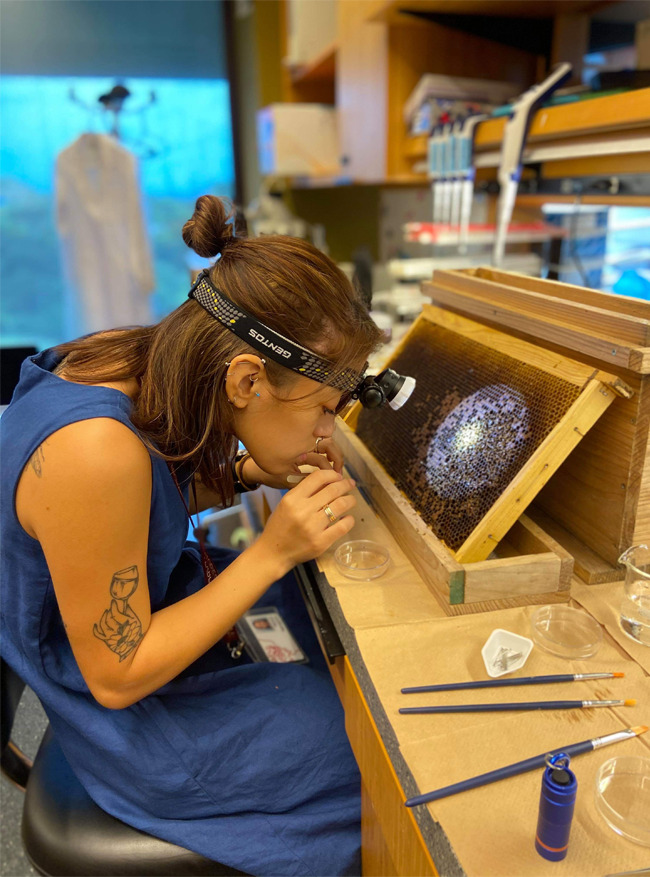The Okinawa Institute of Science and Technology Graduate University (OIST) promotes world-class research by leading researchers. Since the doctoral course was established in 2012, about 40% of the faculty members and about 80% of the students are foreigners at this unique graduate university, and all education and research are conducted in English. In 2017, Nonno Hasegawa entered an integrated doctoral course and is now working on honey bee research.He talked about his encounter with honeybee research, how interesting it is, and the learning and research environment at OIST.
Encounter with bees
When I was a student at the University of Guelph, I got involved in honey bee research during an internship, which sparked my interest.The University of Guelph has a system of 'Co-operative Education Programs'.It is a formally recognized part of the study and is an educational model that integrates study in a relevant field with paid work experience.
Usually, in addition to lectures and practical training at the university, students also participate in a 16-month internship at a private company or other university, etc., and are designed so that they can accumulate practical experience on top of their academic foundation.In the course of my research, I felt the depth of honeybees and at the same time felt their loveliness.
Bee research at OIST
Currently, I am researching a virus transmitted by ticks called varroa mites that parasitize honeybees. Deformed Wing Virus (DWV) is an RNA virus, and the name comes from the fact that the wings of honeybees curl when infected.Originally, the Varroa mite was known as a parasitic mite on oriental honeybees, but in the 1960s to 1980s, it changed hosts to Western honeybees.
In my research, I will unravel the history of host replacement by collecting varroa mite samples from the 1980s to 2019 from around the world and analyzing the distribution of the parasitic virus.Western honeybees collect nectar from a wide variety of flowers and promote pollination in the process.

First paper published
In August 2020, we were able to summarize the two new research methods we developed and publish our first academic paper.One is a method for extracting DNA and RNA from Varroa mite.Comprehensive analysis usually requires large amounts of nucleic acids such as DNA and RNA, but with this method, virus distribution can be analyzed from a small amount of DNA and RNA extracted from a single individual of Varroa mite, and costs can be reduced. .
The other is a new method that can preserve varroa mites for a long time.Biological experiments often use liquid nitrogen at minus 80 degrees to store samples, but it is difficult to bring liquid nitrogen outside to collect varroa mites, and the occasional use of dry ice is not suitable for carrying around. .I solved this problem by mixing ethanol with some solutions.
Episodes leading up to publication
One of the reasons why I was able to present the results in a relatively short period of time after starting my research in earnest was that I was able to learn from the research content and methods of those who were conducting experiments nearby, such as my seniors and colleagues. I think it was interesting.In particular, during my internship at OIST, I received a hint from the researcher who supervised the experiment regarding a new preservation method for varroa mite.
He was researching other bees, and surprisingly, he used an ethanol mixed solution to preserve the antennae.The hardest part was from obtaining the data to writing the paper.Until then, I had created lecture reports, but it was difficult to concisely summarize the results using only the essential information.It also took me some time to master methods I had never used before, such as DNA sequence data analysis and statistical processing.
future of research
So far, my research has focused only on varroa mites that parasitize honeybees, but in the future I would like to target ticks that live on carnivorous plants and arthropods such as flies.The goal is to compare the DNA sequences of carnivorous plants and arthropods to discover the genetic characteristics of species that form symbiotic relationships. At OIST, you can propose a research project that you would like to work on, and if it is evaluated by your supervisor, it will be approved.
I am anxious about taking on the challenge of a new research field, but at the same time, I would like to challenge the limits of how far I can hone my own research performance.
How I Entered OIST and the Skills I Developed at an International School
I came to know about OIST because the researcher who supervised me during my internship at the University of Guelph was from OIST.I took the exam because I was attracted to the world-class research environment and the living environment of Okinawa, which is surrounded by the sea.I also missed my life in Japan and Japanese food.
At the international school, in addition to my English skills, I was able to acquire the presentation and debate skills necessary to succeed in an international environment.I have heard that in Japan's compulsory education, there are almost no classes to hone presentation skills to express oneself in front of others, or debating skills to express one's own thoughts logically while accepting the opinions of others. There were many such opportunities at school, and I think that I gained strength as I stepped on the number of occasions.Both of these are indispensable for advancing research. It was also used for the OIST exam.
Better late than never Expand your future
After obtaining my doctorate, I would like to be active as an expert who can provide scientific advice on policy making.The other day, I was talking to a member of the prefectural assembly, and that feeling became even stronger.My motto is "Better late than never".I have attended several lectures aimed at university students and others, and I always tell them.Young people like me, especially students, have nothing to lose.
Don't be afraid to fail and take on challenges if you have the chance.Even if the timing is a little later than those around you, it's important to take action when you think, "Let's try!"I believe that it will surely lead to expanding my future.
★ Scholarships at the University of Guelph, Canada
The University of Guelph offers a very generous scholarship program to help students continue their studies.
In 2021, more than $4270 million in scholarships will be awarded to students based on their academic performance.Awards may also be given for achievements in extracurricular activities, leadership abilities, and achievements in volunteer activities.
Click here for details(https://www.uoguelph.ca/registrar/studentfinance/scholarships/index)

Okinawa Institute of Science and Technology Graduate University (OIST), XNUMXnd year doctoral program
Nonno Hasegawa
Influenced by her grandmother, she became familiar with English from an early age.She spent a few months at OIST using an internship program while she was still in school to study bees.After that, he passed the difficult selection exam that attracts students from all over the world, and after graduating from the University of Guelph, he entered OIST's integrated doctoral program, where he continues to this day.
